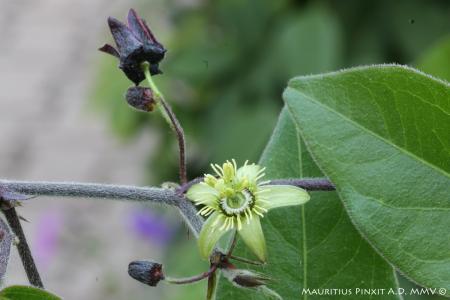
SUBGENUS: decaloba
SUPERSECTION: cieca
GEOGRAPHICAL DISTRIBUTION OR ORIGIN:
Common in all tropical America except in the Guyane.
MINIMUM TEMPERATURE: 8 °C
IDEAL MINIMUM TEMPERATURE: 10 °C
SYNONYMS: P. angustifolia Swartz., P. calliaquatica Krause, P. flexuosa Gardn., P. glabra Mill. P. globosa Vell., P. hederacea Cav., P. hederaefolia Lam., P. heterophylla Aiton non Lam., P. hirsuta L., P. kohautiana Presl., P. limbata Tenore, P. longifolia Lam., P. nigra Jacq., P. olivaeformis Mill., P. oliviformis Vell., P. peltata Cav., P. pseudosuberosa Fisch., P. puberula Hook., ... and others.
ETYMOLOGY: So called for the presence of cork on the stems (Lat. suber)
NOTES: Chromosomes: n=6, 2n=12. n=12, 2n=24 (Storey, 1950). n=12, 2n=24 (Storey, 1950). n=18, 2n=36 (Storey, 1950). 2n=24 (Beal 1971).
DESCRIPTION:
This small and variable species is truly one of the easiest to grow. It spreads everywhere and is not easy to get rid of: it grows in pots close to the specimen being cultivated, but one may also discover small plants in the garden, in the most unexpected places. Its seeds survive the winter outdoors and germinate without problems at the right moment.
P. suberosa is so variable that many botanists have given it different names, not realising that they were dealing with the same species. This explains the proliferation of synonyms that have been attributed to it. On the same specimen, one may even find leaves of different shapes. Sometimes the lateral lobes are very long, while the central one is short. Other times they are almost the same size, or one can also get the reverse, where the central lobe is much longer than the lateral ones. There are forms of P. suberosa with whole leaves, sometimes leathery and spotted!
This plant is appreciated for the aesthetics of its leaves, which have curious, unusual shapes. Over time, the plant and the base of the stems will become increasingly cork-white. After a few years, the build-up of this elegant bark gets to contrast the dark colour of the elegant leaves and the ever-present black fruits, the size of peas.
The flowers are very small, only 9-10 mm, without petals and green in almost all their parts. The corolla consists of only the sepals, above which lies the corona with yellow-green filaments. If you observe them through a lens, you will discover that they are perfect and exactly the same as those of other passionflowers.
This climber is also suited to living in small pots. It is very long-lived and, while growing slowly, it will reach respectable dimensions, even greater than one metre.
It requires rich, soft soil, good fertilisation and frequent watering. It can be placed outdoors in a sunny position, after a period of adaptation in the shade.
Reproduction
from seed will be inevitable, but propagation by agamic means can be done just
as easily.